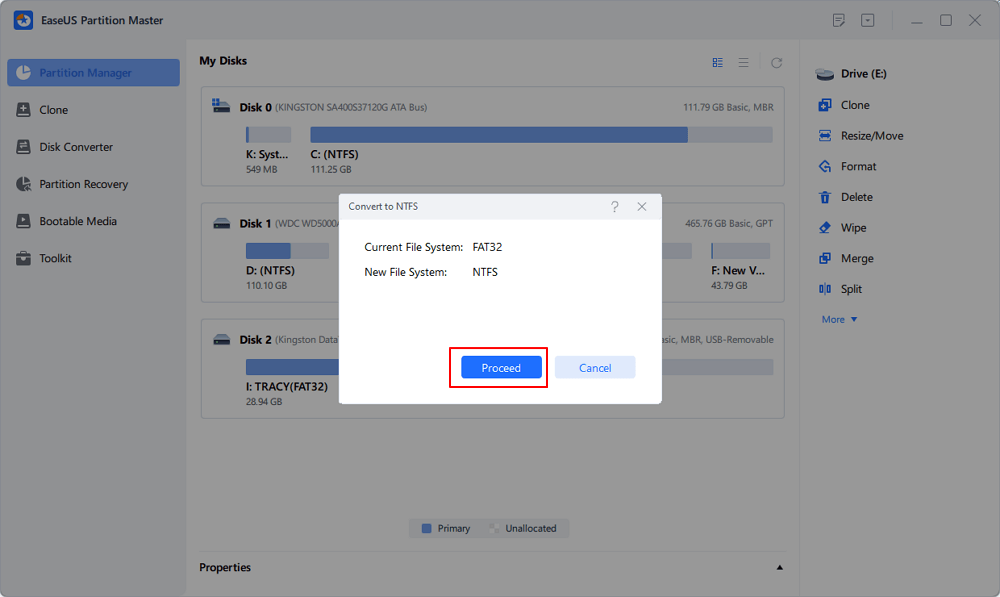

- #Convert fat32 to ntfs cmd how to#
- #Convert fat32 to ntfs cmd install#
- #Convert fat32 to ntfs cmd windows 10#
- #Convert fat32 to ntfs cmd Pc#
- #Convert fat32 to ntfs cmd windows#
#Convert fat32 to ntfs cmd windows#
Here's the step-by-step guide to format NTFS partitions in FAT32 using Windows Powershell.

So, if you're using an earlier version of Windows, you'd have to stick to the previous conversion method only.
#Convert fat32 to ntfs cmd windows 10#
Powershell is a Command-Line utility that's exclusively available on Windows 10 only. You can also use Windows Powershell to format an NTFS drive into FAT32.
#Convert fat32 to ntfs cmd how to#
That's how to convert NTFS to FAT32 CMD in a Windows system. Step 2: Once you're in the Command Prompt window, execute the following command.Ĭonvert d: /fs:fat32 (Replace "d" with the drive letter that you want to format) Right-click the search result and select "Open as Administrator". Step 1: Expand the "Start" menu and type "CMD" in the Cortana search box. Here are three different ways to format a drive from NTFS to FAT32 file system. However, direct formatting will delete the entire data from the drive so it would be better if you are back-up all your files before moving ahead with the process.
#Convert fat32 to ntfs cmd install#
If you don't want to install third-party software or feel like using Windows Disk Management is a complete challenge, an easier option would be to directly format the NTFS drive in FAT32. Part 3: Convert NTFS to FAT32 by Formatting Directly (Data Loss) However, since it's a complicated process, it's better to stick to the AOMEI Partition assistant to do the job. That's it you drive will restore to the actual size and you won't lose any data during the process. Now, select the unallocated space and tap "Extend". Step 6: Again right-click the FAT32 partition and select "Extend Volume". This will create a new unallocated space. Step 5: In the next step, delete the NTFS partition. Step 4: Once the volume is shrunk, format the drive to FAT32, and move the data from NTFS to the new FAT32 partition. Step 3: Type the size you want to shrink and select "Shrink". Step 2: Right-click on the dedicated partition and select "Shrink Volume". Step 1: Press "Windows" + "X" and select "Disk Management". Here's the step-by-step process to convert NTFS to FAT32 using the Disk Management tool without losing data. However, instead of directly formatting the drive to FAT32, you'll first have to shrink the volume to half of its size if you want to keep your data safe. Shrink NTFS disk with Windows Disk ManagementĪnother way to convert NTFS to FAT32 without losing data is to use the Windows Disk Management tool. That's it the file system will be converted to FAT32 and you'll be able to access it on the dedicated OS without any interruption. Simply tap "Proceed" to continue with the process.

Step 4: In the pop-up window, you'll be asked to confirm your actions. Step 3: Now, you'll be asked to select the specific partition you want to convert. Step 2: In the next window, select "NTFS to FAT32" and click "Next".
#Convert fat32 to ntfs cmd Pc#
Step 1: Install and launch AOMEI Partition Assistant on your Windows PC and select "NTFS to FAT32 converter". Moreover, once the job is done, you can again convert the FAT32 partition back to NTFS without any hassle.įollow these steps to convert NTFS to FAT32 using AOMEI Partition Assistant. Unlike the conventional methods, the AOMEI partition assistant will keep your data completely untouched and can be used to convert up to 2TB of volume. The most convenient way to convert NTFS to FAT32 is to use a dedicated tool like AOMEI Partition Assistant. Part 2: Convert NTFS to FAT32 without Data Loss 1. So, let's guide you through different methods that'll help you convert NTFS to FAT32 without losing data. Now, while converting NTFS to FAT32 isn't challenging, the process can cause potential data loss, especially if you directly format the drive using conventional methods. It means if you have a hard drive with NTFS partition, you'll have to convert it to FAT32 before you can use it. However, despite being the older file version, many devices still support the FAT32 file system only. It repairs files automatically in case of any damage It keeps two different copies of FAT if damage occurs Here, one can perform individual compression of files You can set specific permissions to files or folders


 0 kommentar(er)
0 kommentar(er)
